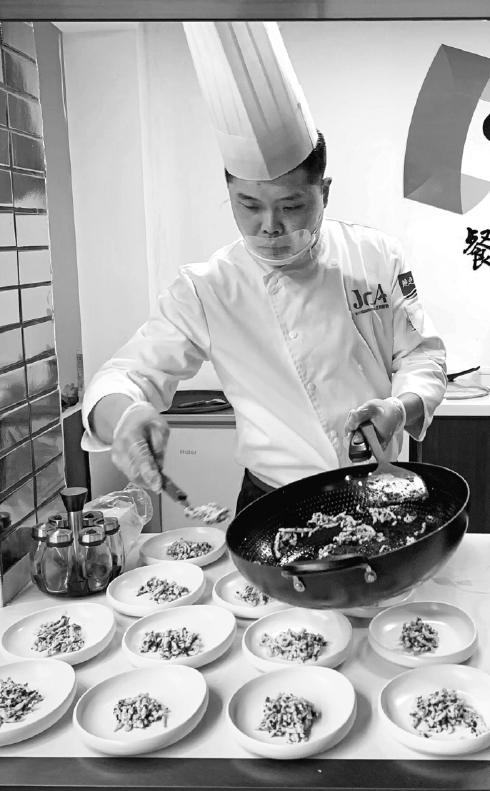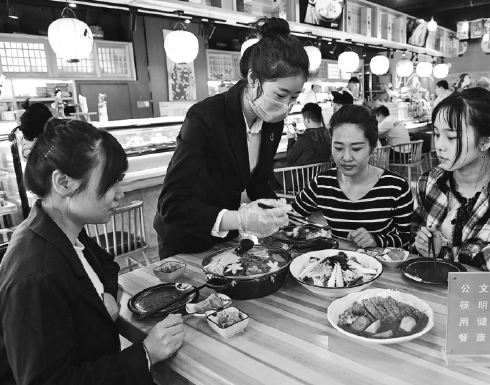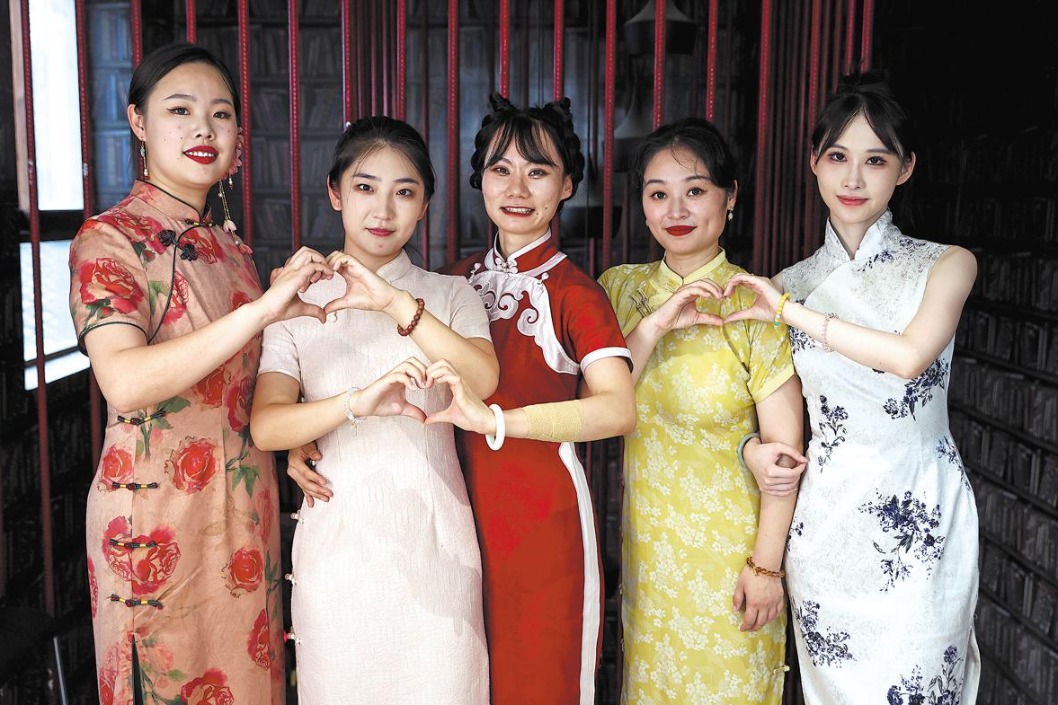Divvying up plates into portions a new fashion
Restaurateurs across the country change way of serving to mitigate risk of spreading virus. Wang Xiaoyu reports.

Before a steaming platter of egg-fried rice was brought to customers, chef Gao Xiaosheng at Pudong Shangri-La Hotel in Shanghai divvied up the dish into six portions and placed them separately onto six plates.
Moving fast to keep the food warm was key, he said. Each plate was preheated and more waiters were assigned to serve the divided portions on time.
All the extra hassle was worth it though, according to Gao. Diners today feel more comfortable sharing a table of delicacies with others this way. The COVID-19 pandemic accelerated the practice of individual plating and serving chopsticks as a means to reduce the risk of infection.
At a traditional Chinese dinner, using individual utensils to pick bite-sized pieces from communal dishes has been proper custom for hundreds of years. It is not uncommon to see a host use his or her chopsticks to take the tastiest morsel of fish meat and place it on a guest's plate to convey hospitality.
The novel coronavirus, which primarily spreads through respiratory droplets emitted when people talk, breathe and eat, has put the long-held tradition into question. Public health experts, catering associations and local governments are all calling for a gradual shift to use designated serving utensils and serve separate portions at group meals.
"There is no doubt that the Chinese way of communal dining has brought about heartwarming and lively moments of friendship and family bonding," said Zhao Wenhua, chief nutritionist at the Chinese Center for Disease Control and Prevention.
But countless health risks come with the tradition, she said. Saliva on used chopsticks and spoons come in contact with shared dishes. In that way, the saliva passes from one person to another, creating favorable conditions for a variety of germs and viruses to spread on dinner tables.
"We have been discussing dividing dishes and using communal utensils for a long time, but implementation was inadequate in the past," Zhao said. "The pandemic has again underscored that more concrete action should be taken."
The catering industry, from upscale fine-dining establishments to time-honored eateries, has responded promptly.
Like their global counterparts, restaurants in China took a hard hit from previous closures and lockdowns aimed at containing the spread of the virus.
Since local transmission of the disease has been effectively brought under control, the majority of restaurants in China have fully reopened. They're now gearing up for the upcoming New Year holiday in early January and the Spring Festival holiday in mid-February. Both holidays are prime times for Chinese people to gather with friends and family members and enjoy hearty meals.
Wang Mingming is the manager of a branch of Hua's Restaurant, a traditional Chinese food chain in Beijing known for its Peking duck and crawfish. He said business at the establishment in Dongcheng district had largely returned to normal since August.
In addition to universal public health measures such as taking temperatures of patrons, providing hand sanitizer and stepping up disinfection, Wang said use of communal chopsticks has also become a mainstay.
"We began offering designated serving chopsticks in May," he said."Each smaller table in the hall with two to four sittings will be given one pair. At private dining rooms that usually host a banquet of more than six people, each dish will be served with one pair."
Communal utensils at Hua's restaurant are customized and marked by gongkuai, Chinese characters for "public chopsticks," in bold, red prints.
"Based on my observation, all diners at the large rooms use the communal chopsticks," he said. "For those seated in two or three, the usage rate of these designated utensils is about 60 to 70 percent."
Hua's restaurant also began offering more items in individual or smaller portions on its menu.
"For instance, customers ordering Bawang chicken-a spicy chicken salad-can choose to take one platter, half the platter or an individual portion," he said."It turns out many diners prefer the smaller size either because they're concerned about food hygiene or because they want to avoid wasting food."
However, not all Chinese dishes can be easily dissected and portioned without compromising flavor and presentation.
At Cui Hua Lou in Beijing, a one-Michelin-starred restaurant specializing in cuisines from Shandong province, most soup and pork dishes can be served in individual portions. That's according to a manager at one of its two chains in Beijing, who is surnamed Chen.
"One of the bestsellers at the chain is the braised mandarin fish in soy sauce," Chen said. "Ensuring that a whole fish is placed on the dining table speaks to the cooking skills of our chefs and fresh ingredients that we use."
Therefore, servers ask customers for their preferences on how to serve dishes that come in big portions.
"Diners have generally appreciated that we are now providing communal chopsticks to every dish and offering to divide large-portioned dishes for them," Chen said." Even though we began serving chopsticks long before the COVID-19 outbreak, the number of people actually using them has increased."
However, he also noticed that when dining with a few family members or close friends, customers have found swapping from one set of chopsticks to another a nuisance. Compliance in those scenarios is much poorer.
In Chinese culture, sharing food with personal chopsticks is a sign of intimacy. Defying the ingrained tradition can sometimes result in misunderstandings.
Lu Hanrong, 52, said when he worked for a factory in Guangdong province in the 1990s, lunch at his workplace was served in individual portions.
"But when I came back to my hometown in Jiangsu province, nobody would divide dishes or use communal chopsticks, whether at home or at a restaurant," he said."It would be strange and out-of-place to request having an individual portion or ask for an extra pair."
Ma Li, a 27-year-old employee in Wuxi city in Jiangsu, planned to visit her family in the countryside during the Spring Festival. She said the pushing of new dining habits could be met with more resistance there.
"In Wuxi, communal chopsticks are very common at formal banquets," she said. "But they remain a rarity in casual meet-up meals. I do not think the practice has yet reached rural areas."
The challenge has come as no surprise to health experts and government officials. They agree that the COVID-19 outbreak is unlikely to be a factor in eradicating a deeply rooted custom. But the disease outbreak does present a valuable opportunity to bring the topic of enforcing new dining etiquette back to the table.
Zhao, from the China CDC, said adopting a new lifestyle and internalizing it among the public will certainly take a long time.
"We need every person to practice the new dining method proactively and consistently," he said."Gradually, these practices can be passed on to future generations."
Xu Hejian, a spokesman for the Beijing municipal government, also said during an earlier conference that fostering the new habit will involve a long-running campaign.
"The key is to persevere, and not forget about the significance of personal hygiene, even after the virus outbreak is completely controlled," he said.



Today's Top News
- China to open its door to foreign investment wider
- China criticizes Canadian tariffs on products containing Chinese steel
- US legislative chaos undermines its democracy
- Why China is irreplaceable in supply chain
- China's FDI inflow tops $700b since 2021
- Australia, China set to bolster steel partnership






























